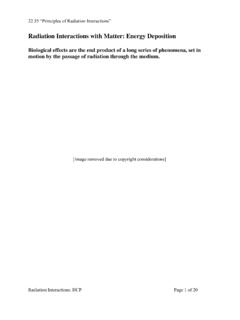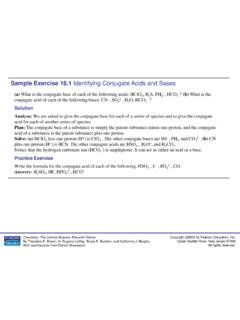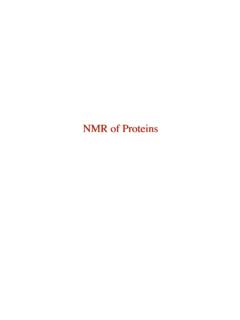Transcription of 6.007 Lecture 38: Examples of Heisenberg uncertainty principle
1 Heisenberg UncertaintyOutline- Heisenberg Microscope- Measurement uncertainty - Example: Hydrogen Atom- Example: Single Slit Diffraction- Example: Quantum Dots1 TRUE / FALSEA photon (quantum of light) is reflected from a mirror.(A) Because a photon has a zero mass, it does not exert a force on the mirror. (B) Although the photon has energy, it cannot transfer any energy to the surface because it has zero mass. (C) The photon carries momentum, and when it reflects off the mirror, it undergoes a change in momentum and exerts a force on the mirror. (D) Although the photon carries momentum, its change in momentum is zero when it reflects from the mirror, so it cannot exert a force on the Wavepacket in SpaceGaussian Wavepacket in SpaceGAUSSIAN ENVELOPEG aussian Wavepacket in SpaceIn free space .. this plot then shows the PROBABILITY OF WHICH k (or ENERGY) EM WAVES are MOST LIKELY TO BE IN THE WAVEPACKETWAVE PACKET3 uncertainty RELATIONSG aussian Wavepacket in TimeWAVE PACKET4 Heisenberg s uncertainty PrincipleThe more accurately you know the position ( , the smaller x is), the less accurately you know the momentum ( , the larger p is); and vice versauncertaintyin momentumuncertaintyin position5 Heisenberg realised that.
2 In the world of very small particles, one cannot measure any property of a particle without interacting with it in some way This introduces an unavoidable uncertainty into the result One can never measure all the properties exactlyWerner Heisenberg (1901-1976)Image in the Public Domain6 Measuring Position and Momentum of an Electron Shine light on electron and detectreflected light using a microscope Minimum uncertainty in position is given by the wavelength of the light So to determine the position accurately, it is necessary to use light with a short wavelengthBEFORE ELECTRON-PHOTONCOLLISION incidentphotonelectron7 Measuring Position and Momentum By Planc ks law E= hc/ , a photon with a short wavelength has a large energy Thus, it would impart a large kick to the electron But to determine its momentum accurately.
3 Electron must only be given a small kick This means using light of long wavelength of an ElectronAFTERELECTRON-PHOTONCOLLISION scatteredphotonrecoilingelectron8 Light Microscopes Suppose the positions and speeds of all particles in the universe are measured to sufficient accuracy at a particular instant in time It is possible to predict the motions of every particle at any time in the future (or in the past for that matter) An intelligent being knowing, at a given instant of time, all forces acting in nature, as well as themomentary positions of all things of which the universeconsists,wouldbeabletocomprehend themotions of the largest bodies of the world and those of the smallest atoms in one single formula,provided it were sufficiently powerful to subject all the data to analysis; to it, nothing would beuncertain, both future and past would be present before its eyes.
4 Pierre Simon Laplace incidentphotonelectron9 Review: Probability - a closer look at xProbability of someone with age j:Average age (expected age):General expected value: where(N)eople Number of PAge (j)10 Review: ProbabilityOne distribution is more spread out than the we ve been loosely calling j is actuallyVarianceExpected (Expected value of j2value of j)2 Standard deviation(N)eople Number of PAge (j)11 Review: ProbabilityA closer look at xProbability of being at position x:General expected value: uncertainty in nme-Expected (average) position: 12 Heisenberg Example:DiffractionWhat is the spread of electrons on the screen ?The slit gives information about onspread and if you look closely you will see ..BarrierBarrierIntensity13 Classical Hydrogen AtomClassically we know that negatively charged electron is attracted to the proton, and it was suggested that the electron circles the proton.
5 But if an electron is circling, every-time it changes direction it is accelerated, and an accelerating charge emits EM radiation (light). Classically, it can be calculated that the radiation of the electron would cause it to gradually loose its rotational kinetic energy and collapse on top of the proton within 10-9seconds ! Hydrogen Atom14 Consider a single hydrogen atom:an electron of charge = -efree to move around in the electric field of a fixed proton of charge = +e(proton is ~2000 times heavier than electron, so we consider it fixed).The electron has a potential energy due to the attraction to proton of:where ris the electron-proton separationThe electron has a kinetic energy ofThe total energy is then15 Classically, the minimum energy of the hydrogen atom is the state in which the electron is on top of the proton p = 0, r = mechanically, the uncertainty principle forces the electron to have non-zero momentum and non-zero expectation value of position.
6 If ais an average distance electron-proton distance, the uncertainty principle informs us that the minimum electron momentum is on the order of energy as a function of ais then:16If we insist on placing the electron right on top of the proton (a=0), the potential energy is still -, just as it is classically, but the total energy is: Quantum mechanics tells us that an ATOM COULD NEVER COLLAPSE as it would take an infinite energyto locate the electron on top of the proton17 The minimum energy state, quantum mechanically, can be estimated by calculating the value of a=aofor which E(a)is minimized:a[ ]E[eV]AS A FUNCTION OF aTHE TOTAL ENERY LOOKS LIKE THIS preventing localization of the electron near the proton, the uncertainty PrincipleRETARDS THE CLASSICAL COLLAPSE OF THE ATOM,PROVIDES THE CORRECT DENSITY OF MATTER,and YIELDS THE PROPER BINDING ENERGY OF ATOMS18 One might ask: If light can behave like a particle,might particles act like waves ?
7 YES !Particles, like photons, also have a wavelength given by:de Broglie wavelengthThe wavelength of a particle depends on its momentum, just like a photon!The main difference is that matter particles have mass, and photons don t !19 Nobel Prize Alfred Nobel was born in1833 in Stockholm, Sweden. He was a chemist, engineer, and inventor. In 1894 Nobel purchased the Bofors iron and steel mill, which he converted into a major armaments manufacturer. Nobel amassed a fortune during his lifetime, most of it from his 355 inventions, of which dynamite is the most famous. In 1888, Alfred was astonished to read his own obituary in a French newspaper. It was actually Alfred's brother Ludvig who had died. The article disconcerted Nobel and made him apprehensive about how he would be remembered. This inspired him to change his to bequeathed 94% of his total assets (US$186 million in 2008) to establish the five Nobel Prizes.
8 Today the Nobel Foundation has US$560 million. Winners receive a diploma, medal, and monetary award. In 2009, the monetary award was US$ NobelImage in the Public Domain20Do particles exhibit interference ?PositionOn ScreenPartitionScreenWith SlitsFiring bulletsat a double -slit with one slitclosedFiring electronsat a double -slit with one slitclosed21 What about the other slit ?Again, you just get a rather expected result ..22 What if both slits are open ?With bullets, you getwhat appears to be asimple sum of thetwo intensity electrons, you findan interference pattern,just like with light waves ?Huh ? Come again ?So, forms of matter do exhibit wave behavior (electrons) and others (bullets) don t ? What s going on here ??????23 Electron DiffractionWallScreenIntensityGraph24 Double-Slit Experiment:act of observation affects behavior of electronDetectorDetectorWallScreenIntens ityGraph25 What is the minimum kinetic energy of the electron in the box?
9 1 nme-Another Heisenberg uncertainty Example: A quantum particle can never be in a state of rest, as this would mean we know both its position and momentum precisely Thus, the carriage will be jiggling around the bottom of the valley foreverParticle in a BoxMACROSCOPICNANOSCALE26 Example: Engineering ColorCell stainingTaking color away from chemists and giving it to electrical DisplayEverything here is a spherical nanoparticle of CdSe !!27 Photo by J. Halpert, Courtesy of M. Bawendi Group, EECS, courtesy ONE-lab and M. Bawendi Group, EECS, Confinementelectron can be anywhere in dotanother way to know xTransmission Electron Microscopy shows the crystalline arrangement of atoms in a 5nm diameterCdSe nanocrystal quantum dot+e+e+er Source unknown. All rights reserved. This content is excluded from our Creative Commons license.
10 For more information, see Semiconductor NanoparticlesRed: bigger dots!Blue: smaller dots!Core ShellCore QuantumDot29 Photo by J. Halpert, Courtesy of M. Bawendi Group, EECS, Dot Devicesactive device region contains a single QD monolayer ~5nm thickImage courtesy ONE-lab andMoungi Bawendi Group, MITD evices:Advantages:QD-LEDsColor, Pattern, Stability, .. QD-PhotodetectorsDetectivityQD-Solar CellsTunable Stacks, EfficiencyQD-Floating Gate Memories Enable Device Scaling50100501000nmOrderedQD Monolayer Source unknown. All rights reserved. This content is excluded from our Creative Commons license. For more information, see Photons carry both energy & momentum. Matter also exhibits wave properties. For an object of mass m, and velocity, v, the object has a wavelength, = h / mv Heisenberg s uncertainty principle : uncertaintyin momentumuncertaintyin position31 MIT Electromagnetic Energy: From Motors to LasersSpring 2011 For information about citing these materials or our Terms of Use, visit.
















